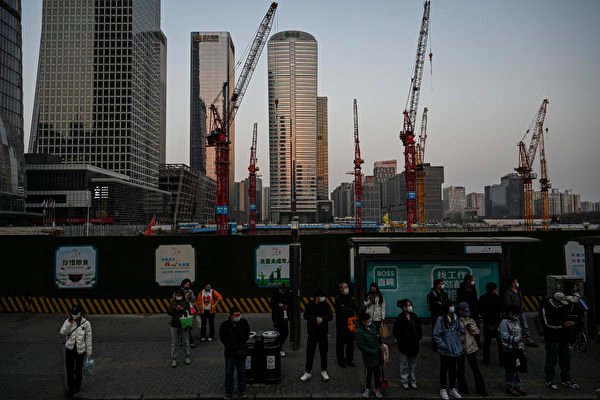The People’s Bank of China announced on Monday (November 11th) the financial data for October, showing that both the increment of social financing scale (hereinafter referred to as “social financing”) and Renminbi loans were lower than expected. The growth rate of social financing hit a new low since 2017. The high scissors difference between M1 and M2 indicates a continuous decline in economic activity. Analysis indicates that the recent series of economic policies implemented by the Chinese Communist Party (CCP) have limited effects, and the confidence of businesses and consumers remains weak.
In October, the increment of social financing was 1.4 trillion yuan, and new Renminbi loans were only 500 billion yuan, both below expectations. The growth rate of social financing slowed from 8.0% in September to 7.8% in October, marking a historical low.
Economists surveyed by Reuters had earlier predicted that the increment of social financing in October would decrease from 3.76 trillion yuan in September to 1.55 trillion yuan, and new Renminbi loans would decrease from 1.59 trillion yuan in September to 700 billion yuan.
Social financing increment refers to the amount of funds obtained by the real economy (domestic non-financial enterprises and households) from the financial system during a certain period. It mainly includes Renminbi loans, foreign currency loans, entrusted loans, trust loans, undiscounted bank acceptance bills, corporate bonds, domestic stock financing for non-financial enterprises, insurance company compensation, investment real estate, and other financial instruments financing ten indicators.
“Due to poor profitability, the demand for corporate financing remains weak,” said Luo Yunfeng, an economist at Huaxin Securities. “Despite the recent policy measures taken by the central bank, credit demand may not rebound quickly.”
The People’s Bank of China did not provide monthly detailed data. According to the data provided by the bank from January to October compared with the data from January to September, Reuters calculated the data for October.
The results showed that household loans, including housing loans, decreased from 500 billion yuan in September to 160 billion yuan in October, while corporate loans decreased from 14.9 trillion yuan to 1.3 trillion yuan.
It is worth noting that government bond issuance accounted for more than three-quarters of the increment of social financing in October for the third consecutive month, exceeding 1 trillion yuan.
Goldman Sachs analyst Chen Xinquan stated in a research report, “The October credit data shows that the demand for credit in the private sector remains weak. The growth of household and corporate loans remains low, with lending mainly driven by short-term financing.”
Bloomberg quoted economist David Qu’s analysis, stating, “The credit disbursement by Chinese enterprises in October was far below the average level from 2019 to 2023, indicating that the impact of the stimulus measures announced since the end of September on the economy is limited. Before significant rebound in business confidence, continued policy support is needed.”
In recent months, especially since August, due to the long-standing slump in the real estate market and the swelling of local government debts, the Chinese economy has been in a dire situation, and the CCP has introduced multiple monetary and fiscal policies to stimulate the economy in September and October.
On September 24th, the People’s Bank of China announced various monetary easing measures, including reserve requirement ratio cuts, interest rate cuts, and reducing the rates on existing housing loans.
On October 12th, the Ministry of Finance of the CCP did not introduce new fiscal stimulus policies, but reiterated existing policies, including 1 trillion yuan in local transfer payments, supporting local governments in financing their expenditures.
On October 17th, the Ministry of Housing and Urban-Rural Development of the CCP also introduced some real estate stimulus measures, including lifting restrictions on property purchases and sales, lowering interest rates on second-home mortgages, reducing interest rates on provident fund loans, increasing the credit scale for projects on the real estate “white list” to 4 trillion yuan, and implementing the renovation of 1 million sets of urban villages and dilapidated housing.
Additionally, data shows that at the end of October, the broad money supply (M2) balance was 309.71 trillion yuan, an increase of 7.5% year-on-year. The narrow money supply (M1) balance was 63.34 trillion yuan, a decrease of 6.1% year-on-year. The scissors difference between M1 and M2 was -13.6%.
When M1 is greater than M2, and the scissors difference is positive, it usually indicates an increase in cash flow in the market, optimism towards the future economy, and a willingness to engage in more consumption and investment.
Conversely, when M2 is greater than M1, and the scissors difference is negative, it often signals economic weakness or monetary tightening because a decrease in liquid funds may lead to a decline in consumption demand and investment activities, thereby affecting overall economic growth.
It is evident that in the second half of the year, the scissors difference between M1 and M2 is negative and both are above -10%, indicating a contraction in economic activity and lethargic economic growth.

